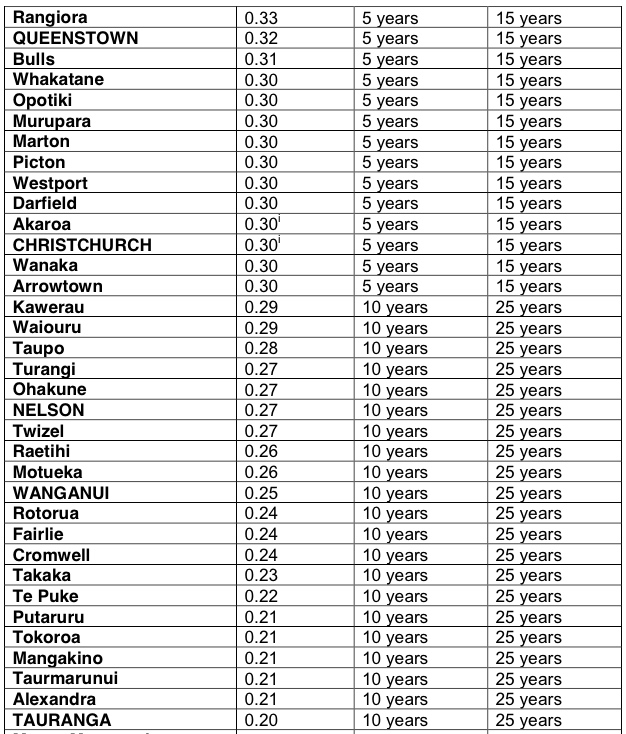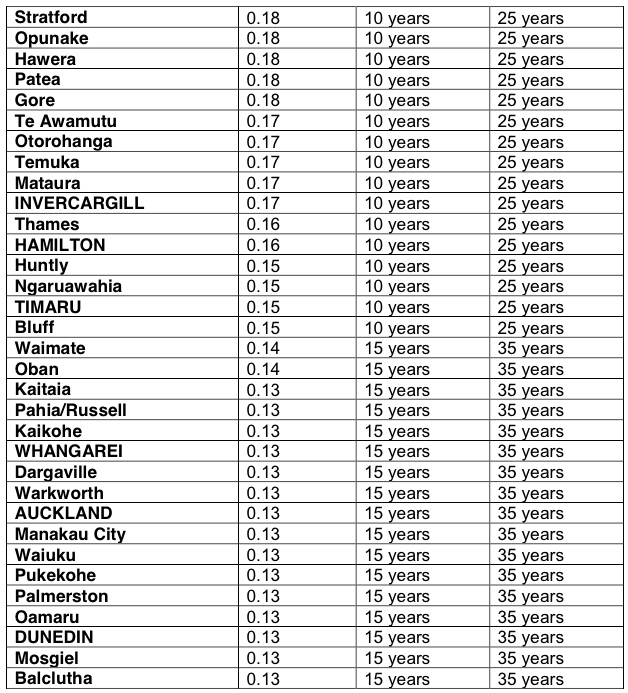The rules for strengthening time-tables may be relaxed, but I’m not sure if I am… I’m not sure if this the result of a carefully planned out Government policy, or if it is just Nick Smith blowing off steam: the two seem closely related. The way that the media report it, the policy seems to have just arrived out of thin air, but actually, I suspect it is a result of lots and lots of thorough number-crunching by some bods from Stats, and an engineer or two down at Mobie central.

This useful, colourful little map will be highly important in the years to come – it nearly relates exactly to the old NZ EQ zones, i think, but seems to have extended a bubble of influence over towards the devastated Christchurch. Wellington, Napier, Gisborne, and the whole of the Southern Alps zone, of course, gets branded as the danger zone. Auckland, Northland, and a thin sliver of the west coast of the South Island gets let off the hook for a few more years. The time table associated with this is long – I’m posting up 3 chunks of info.

Top the list is not, actually, Wellington, but Otira. Home of the Gorge of the same name – but I didn’t even know there was a town associated with that. I presume that there is in fact only a relative handful of buildings there. A bit further down the list, we can see the time scale start to be lengthened out:

And then of course, there is the bottom of the table – the places that time forgot – or rather, the places that can smugly put this on the back burner for another quart of a century or more. Time enough for us to figure out how we are going to afford this.






According to this article, the changes to the Act also mean that the number of Inspections needed has dropped from 500,000 down to only 30,000.
http://www.stuff.co.nz/national/68421102/major-changes-to-earthquake-strengthening-rules
“The definition of an “earthquake-prone building” being one that was less than 34 per cent of the new building standard would remain in the policy, as would a 10-year extension for listed heritage buildings and exemptions from strenghtening for low-risk, low-occupancy buildings. Smith said the more targeted approach would reduce the estimated cost from $1.360 billion to $777m while retaining the safety gains.”
And then of course there is the opposing view, held by Ann Bowers.
http://www.stuff.co.nz/the-press/news/68424118/earthquakeprone-building-assessments-fall-short-survivor-says
It would be nice to know exactly what the legislation says, so we can find out for ourselves what is in it…
What does this mean in practice for towns and cities like Whanganui? With more time before the deadline, do their commercial tenants renew their leases, or do owners end up with years more of buildings that can’t be tenanted and the strengthening of which can’t be financed? Bigger, architecturally better zombie towns?
The cynic in me thinks that the real reason the Nats have extended out the deadline is that they know they will be out of power by then, and someone else will have to deal with this mess… but yes, Wanganui has not been thrown a lifeline, so much as perhaps just a slightly longer piece of string… Places like Wanganui, sadly, are doomed, at least architecturally. There’s just not the money in the local economy for anything much in the way of expensive strengthening jobs.
I’ve been trying to find the actual Bill that Smith keeps talking about, but can’t. Perhaps it does not yet exist. Mean time, here is a link to Nick Smith’s statement about what he plans to do:
https://www.beehive.govt.nz/speech/more-targeted-approach-earthquake-prone-buildings